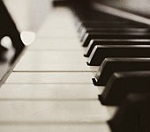
Home > Beginner Piano Lessons > Layout of the Black Piano Keys
|
||||
Layout of the Black Piano Keys
An accidental note refers to any note that is not within the scale or mode being played. Learning the layout of the black piano keys requires having a basic understanding of the layout of the piano white keys. The black piano keys are referred to as sharp (#) or flat (b) notes. A sharp note is a note one semitone higher than normal. A flat note is a semitone lower than normal. The black piano key can be identified as a sharp or flat note. You can always identify what note a black key is by the adjacent white keys. For example, there is a black piano key between the white C and D keys. The black key is to the right of the C key, indicating it is a semitone higher. The black key is to the left of the D key, indicating it is a semitone lower. As a result, this black key is the C# and Db key. All other black keys can be identified in the same way. The layout of the black piano keys has an alternating group of two black keys and three black keys along the length of the piano. The reason for this layout is because the notes in the C major key are not an equal distance apart from one another in terms of pitch.
Musically, black keys are not automatically accidental notes when played in a song. The layout of the piano keyboard, standard music notation and Western music theory are built around the C major scale. For example, the F# scale (F# G# A# B C# D# E#) has accidental notes on the black and white keys. For simplicity, the black keys are usually referred to as accidental notes, but you should realize this term is not necessarily accurate. The accidental notes are related to the scale or mode being played, so any note can potentially be an accidental note. The black keys on the piano are specifically accidental notes to the C major scale. Playing accidental notes from music notation can help reinforce the location of these keys substantially. Normally, the lines and spaces on music notation only correspond to the white keys. The black keys are only played when a note has a “#” or “b” symbol in front of them. For example, if the middle C note in music notation has a “#” symbol in front of it, you play the black key to the right of the white middle C key. With practice, you can reinforce the layout of the black piano keys in your mind by practicing using them in songs.
http://pianoplayerworld.com/300PagePianoWorkbook.html
| ||||
|
Although every attempt has been made to make information as accurate as possible, we are not responsible for any errors that may appear.
 The white keys on a piano consist of all the notes in the C major scale (C D
E F G A B) or any of its related modes. The black keys are accidental notes to these scales and modes.
The white keys on a piano consist of all the notes in the C major scale (C D
E F G A B) or any of its related modes. The black keys are accidental notes to these scales and modes.
 Most of the notes in the scale are a full tone apart. However,
two groups of notes, B-C and E-F, are one semitone apart. There is no accidental note between B-C and E-F, so
there are no black keys between these two sets of notes.
Most of the notes in the scale are a full tone apart. However,
two groups of notes, B-C and E-F, are one semitone apart. There is no accidental note between B-C and E-F, so
there are no black keys between these two sets of notes.



